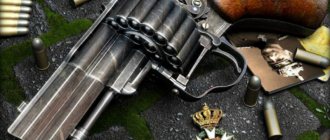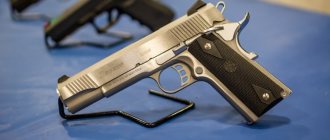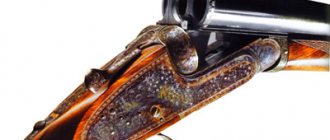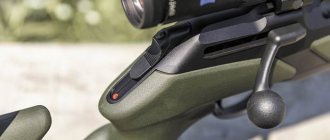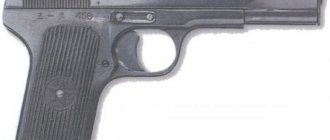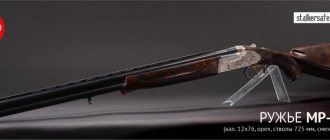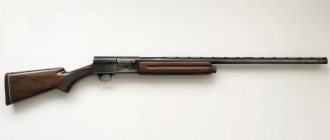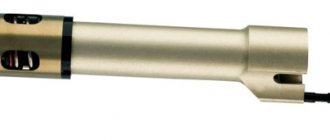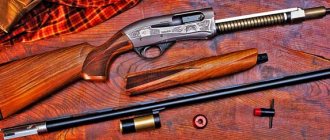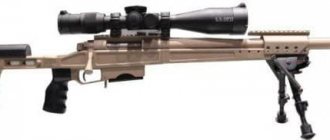Contrary to the opinion that pneumatic guns are a toy that is not capable of serious things, pneumatic weapons have increasingly begun to be used in hunting. Well, yes, everything is logical - pneumatics are lighter, the noise of a shot is not comparable to a firearm. Why not?
But it is still worth considering some points separately, since theory and practice, as is often found in our laws, diverge. Please note that purchasing pneumatic weapons with muzzle energy over 7.5 J is impossible without a license. Therefore, relying on this aspect is inappropriate.
Characteristics of air guns
Let's take a closer look at the advantages of air blowers:
- Shot volume. When firing a firearm, the sound of the shot can be heard for several kilometers, which can scare off potential prey. Air guns are more delicate in this regard.
- It is also necessary to disassemble and clean such weapons, but this needs to be done much less frequently than when working with firearms. It does not form carbon deposits and is less susceptible to rust.
- Even a powerful air rifle with a muzzle energy of more than 7.5 J will be safer than a firearm.
- The cost of pneumatics and ammunition for it is significantly lower than that of smoothbore guns. This is especially true for rifles with a spring-piston operating principle.
- Low recoil and, as a result, lower requirements for the scope. But this is true when it comes to PCP (Pre-Charged-Pneumatics) rifles. And for rifles with a spring-piston mechanism, a special sight is required that is resistant to recoil. While a firearm creates direct recoil and pushes the shooter into the shoulder, a spring-piston rifle, due to the movement of the piston, creates a reverse recoil that pushes the weapon forward. In terms of its impact force, the reverse recoil will be even more severe than the direct one.
- The high accuracy of pneumatic weapons is comparable to the accuracy of rifled weapons.
Compression pneumatic device
In systems with single-pump airguns, otherwise known as compression systems, the compressed air is located in a reservoir built into the rifle or pistol. Pumping is carried out by the shooter only once. The lever moves the piston which compresses the air in the reservoir. As a rule, the piston is one of the walls of the tank. After cocking, the piston is kept pressed, and at the moment of firing, the release valve opens, separating the tank and the barrel. The air supply in the tank is only enough for one shot.
Permit for pneumatics - legal requirements
Yes, pneumatics have a lot of advantages, but which one is suitable for hunting? What to do with a license and is it needed? Let's talk.
Absolutely all pneumatic weapons with a power of up to 3 J are not considered weapons in principle. Therefore, such pistols and rifles can be safely purchased without a license, but they are unsuitable for hunting, but they are suitable for recreational shooting. To purchase a weapon with a muzzle energy from 3 to 7.5 J, you will need to present a passport, and before purchasing a barrel with a power from 7.5 to 25 J, you will need to obtain permission from the Russian Guard, the same place where licenses and permits for firearms are issued. But with such a rifle you can perfectly hunt even large game.
But there is a nuance here. The manufacturer often uses a trick and underestimates the power of its products, leaving the possibility of modification and tuning. For example, a rifle with 7 J of power can be turned into a serious weapon just by replacing the spring. According to the documents, your rifle is not subject to licensing, but in fact, you are breaking the law by using powerful pneumatics without a license. It is impossible to conduct an on-site check, but law enforcement officers can seize the weapon and send it for examination. And then problems with the law are guaranteed. Therefore, you should still not do handicrafts where it is fraught with such troubles.
Basic blocks of technical solution
Knowledge of the material base is the first step to proper handling of weapons and the key to successful shooting. Let's consider the main blocks of pneumatic design.
Percussion apparatus
The structure of the impact mechanism in pneumatics is simpler than in firearms. The unit ensures the opening of the valve on the gas tank. After the impact, the gas rushes into the barrel and pushes the bullet out. The striking apparatus uses a mainspring - on a plate or screw rod. A spring closes the valve to hold the gas so another shot can be fired.
Triggers in pneumatics are implemented in open or hidden form, for automatic or manual cocking.
Charge supply unit
Single-shot weapons do not have a magazine; the cartridge is placed in the barrel. In multi-shot pneumatics I use the following types of supply and storage of ammunition:
- gravitational scheme - for explosive balls;
- forced feed – conveyor mechanism or spring;
- revolving type drum mechanism.
In pneumatic pistols, magazines are often built into the handle, which gives them a complete resemblance to military weapons.
Trunk
The material and quality of the barrel determine the shooting accuracy and durability of the weapon. Common materials are steel, brass; the cheapest models often use plastic.
Pneumatics usually have smooth barrels, while rifled barrels are designed to fire lead bullets. Rifled rifles provide greater power and shot accuracy, and repeatability of parameters.
The bullet entrance has a cone shape, which helps keep the bullet in the barrel. The pneumatic caliber starts at 4.5 millimeters, which corresponds to the diameter of the barrel. Experienced shooters advise buying rifles with a fixed barrel. These models demonstrate greater accuracy. Expensive types of pneumatics with a movable barrel are equipped with compensators that improve shooting performance, but make the weapon more expensive.
Circuit breakers
Safety guards provide protection against accidental discharge. There are mainly 2 types used in pneumatics:
- Trigger mechanism latches. They block the trigger parts, the trigger goes into a stationary state.
- Breaking connections in the trigger mechanism (analogous to neutral in a car). The trigger moves, but the shot is impossible.
In expensive pneumatic models, more complex protection methods are implemented - automatic fuses. In particular, the trigger is blocked when the barrel is not closed, and it is impossible to fire if the hand does not clasp the handle. Some models are equipped with an indicator for setting the fuse.
Locking unit
There is no classic shutter in pneumatics. Locking is required to prevent the gas needed to power the bullet from escaping. Technical solutions in each type of weapon are different: seals in piston systems, retractable bushings that move the valve into place, a moving part of the barrel in systems with cartridges.
Operating principle
Compression weapon. It works using compressed gas contained in a tank inside the weapon. When fired, the dispenser releases the amount of gas for the necessary acceleration of the bullet in the barrel. The convenience of this type of work is that you do not need to reload the weapon every time, the downside is that when pumping, special equipment is often required. Although in some models muscle force may also be used for this. One pump should be enough for 10 shots.
Multi-shot gas sports pneumatic rifle MP-555K (19545) Baikal 19,890 for 1 piece. Air rifle SNIPER-X2 (SHB) cal 4.5mm EVANIX 102,990 for 1 pc. Air rifle RCP VR1763 Benjamin Marauder (wood) cal 4.5mm Crosman 68,795 for 1 pc. Air rifle EDgun Lelya 2.0 cal 6.35 EDgun 94,990 for 1 piece. Repeating air rifle Bullpup M2 416/RB (SL) ATAMAN 88,000 for 1 pc. Air rifle RAINSTORM (Bullpup) cal 4.5mm EVANIX 61,995 for 1 piece. Air rifle Bullpup ML15 B26/RB ATAMAN for 1 pc. Air rifle Hatsan AT44-10 Wood (PCP, wood) cal. 4.5 mm Hatsan 42 890 for 1 piece.
PCP type air rifles
Spring-piston system. As is already clear from the name, the principle of operation is to use the energy of a compressed spring to fire a shot. It straightens, pushes the piston in the cylinder, and it, in turn, begins to move, pumping air that pushes the bullet out. The advantages of such a system are extreme simplicity, reliability and low cost. There are also disadvantages - the need to reload after each shot, as well as the length of the barrel - even for a pistol it is as much as 22 centimeters, which is quite a lot. Another feature of the PP system is the breaking barrel; the spring is cocked in exactly this way.
Air rifle Striker Edge cal. 4.5 mm Hatsan 9 990 for 1 piece. Air rifle Striker Alpha cal. 4.5 mm Hatsan 6,990 for 1 piece. Pneumatic rifle numbered MP-512 -26 birches. stock, (51276) Baikal 7,990 for 1 piece. Air rifle BIG CAT 1250 rifle LC4x32WR Gamo 16,480 for 1 pc. Air rifle 125TH (fracture, plastic) cal. 4.5 mm Hatsan 20,990 for 1 piece. Air rifle Crosman MTR77 NP Crosman 16,995 for 1 piece. Air rifle 440 Hunter Gamo 15,745 for 1 piece. Air gun X5 Synthetic rifle 30153 Stoeger 8 250 for 1 pc.
Choose an air rifle with a spring-piston system
Gas-type pneumatics. The gas used is carbon dioxide in sealed cylinders that are inserted into the handle. At the same time, the capsule breaks through the partition and the gas is now retained in the cylinder only due to the metering valve. The caliber of weapons with this type of action can reach serious 9 mm, however, due to the low power, licensing does not require being on the public market. The main drawback is that the weapon can remain in a charged state with a cylinder inside for a limited time, since the gas is still slowly released.
Pneumatic pistol PM49, cal. 4.5mm BORNER 6,890 for 1 piece. Pneumatic pistol PM (5.8171) Umarex 7,490 for 1 piece. Pneumatic automatic machine S47, 4.5 mm, metal/wood, 120 m/s Stalker 25 285 for 1 pc. Pneumatic pistol МР-654К-22 with false silencer, cover handle (84187) Baikal 11,290 for 1 pc. Pneumatic pistol PM Ultra (5.8131) Umarex 8,390 for 1 piece. Pneumatic pistol MP-651K gas cylinder, row (30508) Baikal 5,390 for 1 piece. Pneumatic pistol CLT125, cal. 4.5 mm BORNER 4 790 for 1 piece. Pneumatic revolver Super Sport 703 cal. 4.5 mm BORNER 11 690 for 1 piece. Pneumatic pistol C11, cal. 4.5 mm Crosman 4,765 for 1 piece.
Select a gas-cylinder pneumatic
Classification of calibers
The most popular caliber for pneumatic weapons is considered to be 4.5 mm, which is classified as recreational, but in some cases it is also used for hunting. For PCP rifles, the most common caliber is 5.5 mm. Rarely used: 11.43; 12.8; 14.5 mm, etc.
Available in sizes:
- small: 4.5; 5.0; 5.5; 6.35 mm;
- average: 7.62; 8; 9 mm.
Pneumatics must be purchased from a specialized store with competent advisory support, giving preference to popular brands.
For each model, the seller must have a certificate of conformity. May 21, 2022
Examples of pneumatic systems and components[edit]
- Air brakes on buses and trucks
- Air brakes on trains
- Air compressors
- Air motors for air driven vehicles
- Barostat system used in Neurogastroenterology and electrical research
- Cable laying, method of laying cables in channels
- Dental drill
- Air motor and pneumatic actuators
- Gas overload
- Holman Projector, an air-powered anti-aircraft weapon
- HVAC Control Systems
- Inflatable structures
- Lego pneumatics can be used to create pneumatic models
- Organ Electro-pneumatic action
- Pipe-pneumatic action
- Jackhammer used by road workers
Comparison with hydraulics[edit]
Both pneumatics and hydraulics are applications of hydraulic power. Pneumatics use a highly compressible gas such as air or a suitable clean gas, whereas hydraulics use a relatively incompressible liquid medium such as oil. Most industrial pneumatic systems use pressures of approximately 80 to 100 psi (550 to 690 kPa). Hydraulic applications typically use pressures between 1,000 and 5,000 psi (6.9 and 34.5 MPa), but can exceed 10,000 psi (69 MPa) in specialized applications. [ citation needed
]
Advantages of pneumatics[edit]
- Simplicity of Design and Operation -
Machines are easily designed using standard cylinders and other components and operate with simple on/off control. - Reliability.
Pneumatic systems typically have a long service life and require little maintenance. Because the gas is compressed, equipment is less susceptible to shock. Gas absorbs excessive force, whereas fluid in hydraulics directly transmits force. The compressed gas can be stored, so the machines can continue to run for a while if there is a loss of power. - Safety
- the risk of fire is very low compared to hydraulic oil. New machines usually allow overloading up to a certain limit.
Advantages of hydraulics[edit]
- The liquid does not absorb the supplied energy.
- Capable of moving much higher loads and delivering much higher forces due to incompressibility.
- Hydraulic working fluid is largely incompressible, which minimizes spring action. When the flow of hydraulic fluid stops, the slightest movement of the load relieves pressure on the load; there is no need to “bleed” compressed air to relieve pressure on the load.
- High sensitivity compared to pneumatics.
- Delivers more power than pneumatics.
- It can also perform multiple tasks simultaneously: lubrication, cooling and power transmission.
History[edit]
The origins of pneumatics go back to the first century, when the ancient Greek mathematician Hero of Alexandria wrote about his inventions powered by steam or wind.
The German physicist Otto von Guericke (1602–1686) went a little further. He invented the vacuum pump, a device that can pump air or gas out of a container attached to it. He demonstrated a vacuum pump for separating pairs of copper hemispheres using air pressure. The field of pneumatics has changed significantly over the years. It has moved from small handheld devices to large machines consisting of multiple parts that perform different functions.
Types of air guns
All types of air guns work on the same principle. They eject a projectile, a lead bullet or metal ball, with high-pressure compressed air. Based on the type of formation, pneumatic weapons are divided into the following types.
- Spring-piston. This is a single-shot pneumatic pistol familiar to all teenagers from the USSR. To retract the piston to the working position, the barrel had to be pulled down until it clicked.
- Compression and multi-compression. This air gun is charged with several movements of the lever. Each time, a portion of air is supplied to the working chamber with increasing pressure. At the same time, the multi-compression pistol allows you to fire several shots.
- Gas cylinders. The source of air in such devices is a pre-charged container. A gas air gun is the easiest to use, but its characteristics are rather modest.
- With pre-pumping. So-called PSP systems use a source of compressed air in the form of a container, where it is pressurized up to 300 atmospheres. This is a large volume. PSP pistols provide maximum shooting accuracy, stable bullet trajectory parameters, and high initial velocity.
Do not confuse freely sold air guns with special purpose devices . Some of them may be considered weapons of premeditated murder. An air pistol with a retractable impact rod is intended for the slaughter of cattle by breaking the skull and cannot be qualified as a means of self-defense.
It’s a completely funny situation when a beginner focuses on big names. A needle air gun is not a weapon, but a device for removing rust and paint coatings. To avoid mistakes, before going to the store, you should get as much data as possible that will allow you to navigate existing technical solutions.
Hunting
A class of weapons suitable for hunting game and small animals is represented on the pneumatic market by spring-piston, PCP and rifles operating with air cartridges. Note that rifles with single and multiple pumping are inconvenient to use for hunting purposes, due to the need to spend a certain amount of time preparing the weapon for a shot. The designs of air rifles, the principle of which is to use reduced gas pressure, are very sensitive to ambient temperature, which means their use is possible only in the warm season.
To ensure that hunting for small animals and game brings you maximum pleasure, it is recommended to use rifles with a stable fire. The series of shots should be predictable and repeatable. It is these qualities that allow shooting without the use of wounded animals. Do not forget that the most important characteristic that an air rifle for hunting should have is accuracy.
MAKSIMOV.SU
When shooting in rough terrain,
the likelihood of difficult-to-predict wind air currents sharply increases. Rifle "Varmint" ATAMAN caliber 6.35 mm on shooting rests manufactured by IP "Yasenchuk A.O."
In the first part of the article, we familiarized ourselves with the main criteria for successfully choosing a PCP rifle for high-precision shooting at maximum distances,
and also considered a number of the most important issues regarding setting up the rifle and choosing an optical sight that corresponds to the tasks.
Today
We will touch on the topic of selecting additional equipment, and also talk about proper cleaning, the basics of saving and operating a PCP rifle, including, which is relevant for our country, in the winter.
At the end of the article, data are provided from the analysis of the results of shooting the Varmint rifle produced by the domestic company ATAMAN. Caucasus
Choice
additional equipment and equipment
In addition to the rifle with optics
we will need a gas station and a high-pressure cylinder (a budget option is a hand pump). This is something without which you simply cannot use a weapon. For an accurate long-range shot you also need: a laser rangefinder, a ballistic calculator (optional, but a desirable option), a portable weather station (in most cases, an anemometer will be enough to control wind speed.
Also
you need stable supports for the fore-end and butt (bipod or support bags, the latter being preferable), as well as selected high-quality bullets. A multi-charge magazine, which is usually not included with the rifle, will not be superfluous.
Rifle case
"Stich Profi"
In most cases
You can’t do without a good case for the rifle (it can also be used as a mat) and a bag for the high pressure cylinder, and if you plan to move with the rifle, then a reliable shoulder strap will be very useful. Of all of the above, the following are successfully used in my practice: Czech JSB bullets, Yukon and Nikon rangefinders, Skywatch anemometer, tactical rifle case and silent shoulder strap produced by Stitch-Profi, Chinese Harris-type bipods and a clear (and very successful!) example of import substitution - leather shooting rests produced by IP Yasenchuk A.O.
If the circumstances
do not allow you to immediately equip yourself in full or the shooter is not faced with the task of squeezing the maximum out of the rifle and fully realizing the personal potential of the athlete, then the additional equipment for the first time will be a pump (or HP cylinder) of a rangefinder. The acquired experience and ingenuity will, to some extent, compensate for the lack of everything else.
The Stich Profi rifle case is designed to transport a rifle with accessories and additional equipment, but can also be used as a mat
Cleaning and Saving
PCP rifles
Practitioners' opinions
When it comes to cleaning pneumatics, they differ to the point of being completely opposite. Some people don’t clean the pneuma at all, others do it with a fundamental approach, according to the methods of high-precision “firearm” shooters. Collective experience boils down to the fact that it is still necessary to clean pneumatics, but, as they say, without fanaticism.
For
Airgun barrels are usually made of steel that is quite soft and prone to rust, so careful handling of the rifle will not be a bad idea. I note that all of the recommendations below apply only when using lead bullets (without copper plating).
There are two reasons
for cleaning an air rifle. Let's start with the first - loss of accuracy, which can happen either after 100 or after 1500 shots. This depends on the consistency of the bullet with the barrel, on the lubrication of the bullets or lack thereof, as well as the shooting conditions: for example, with increased humidity, accuracy deteriorates faster or random separations appear.
Before cleaning
It's better to dismantle the barrel. On ATAMAN rifles this is easy to do; you just need to unscrew the two barrel mounting screws in the receiver and pull the barrel or receiver assembly forward. Why is it not advisable to clean the barrel directly on the rifle? Firstly, when a patch is introduced from the treasury side, the cleaning agent enters the combat valve through the bypass. This happens even after blowing the cleaning agent through blank shots: it will be sprayed onto the firing pin elements.
Such a “lubricant”
valve or striker elements leads to unstable operation of the air supply system, which will be reflected in speed jumps and deterioration of accuracy. A “lubricated” firing pin mechanism can also lead to the build-up of sand and dust during operation, which will increase instability or lead to scoring on dry sliding surfaces.
For cleaning pneumatics
ATAMAN service center recommends using a “broach” (flexible cleaning rod) and high-quality calibrated felt cylinders (patches), which are represented on our market by foreign or domestic products. In my case, “import-substituting” products produced by the Russian company CHISTOGUN (including the A2S GUN line) performed remarkably well.
Compared
With any textile patches, felt cleans the barrel of lead much better, which allows you to reduce the cleaning time by at least 2 times and extend the life of the barrel. Unexpectedly, the optimal oil for cleaning pneuma is the German Ballistol. Of course, in professional services for “severe cases” more aggressive options are also used, but they are used extremely rarely and the cleaning is still completed with “Ballistol”.
Necessary tools and consumables for cleaning a PCP rifle:
Ballistol oil, a flexible universal cleaning rod and 7.5 mm CHISTOGUN felt patches
Now about the cleaning method.
We insert a flexible cleaning rod into the barrel and, from the treasury side, screw a felt patch of the required caliber onto its tip. We apply a small amount of Ballistol to it and, if the barrel is removed from the rifle, insert a patch into it to the depth of the bypass hole (about 10 mm), through which we add more oil and pull the patch from the treasury to the muzzle.
We repeat
this operation until the “white patch” and the absence of lead “spangles” on it. If preservation is not the task, we wipe the barrel dry. Then we fire a few dry shots to remove the oil from under the O-ring in the barrel and run the dry patch again. Finally, we clean the rammer spout and other parts of the rifle from the cleaning agent with a dry rag.
We remember that
that the patch is always pulled in the direction of movement of the bullet, that is, from the treasury to the muzzle, even if the barrel was not removed. If you still don’t want to remove the barrel or this is impossible, use a minimal amount of oil (if it is possible to turn the rifle upside down and secure it in this position for cleaning, you can avoid its disassembly and the risk of oil getting into the mechanism).
Upon completion of cleaning
We disassemble the firing pin mechanism and wash the guide and the firing pin itself with gasoline or alcohol. It is highly not recommended to disassemble the valve! By the way, if you use the excessive “Diver” setting of the rifle, unauthorized lubrication of the valve will not affect the stability of the system.
The second reason for cleaning a PCP rifle:
removal of condensation and natural precipitation to prevent rust. In winter, condensation forms on a rifle brought into the house. This problem can be minimized by leaving the rifle in its soft case for several hours. But if moisture cannot be avoided, it is recommended to run a dry or slightly moistened “Ballistol” or WD-40 patch along the barrel (maximum two passes, despite the dirt coming out).
Pneumatic experts do not recommend
There is no need to completely clean the rifle, since after this there is usually a need to lead the barrel (to bring the barrel to a stable maximum accuracy), for which you need to fire from 5 to 50 shots.
Shooting a precision rifle while standing
requires consistent skills
Recommendations
operating instructions for a PCP rifle with gearbox
Temperature regime.
Almost all PCP rifles can be operated at ambient temperatures down to -25C. Of course, not all manufacturers take responsibility for officially declaring permissible operating temperatures below -10-15C, but this is not the limit provided that low-temperature lubricants are used for the moving elements of the shutter and trigger or good old “dry” operation.
Air
expands when heated.
Therefore, before bringing a geared rifle from the street (where the temperature is 0C or below) into a warm room, you must lower the pressure below the gearbox so that the same gearbox opens. Then there will be no damage to the locking surfaces of the gearbox, which can lead to unwanted “leaks” (when the gearbox, after closing, slowly passes air from the reservoir into the additional volume to the firing valve, that is, the working pressure of the shot instead of, for example, 130 Atm can increase to 300 A as minimum will manifest itself in a drop in the muzzle velocity of the first shot and can damage the combat valve. Sports shooters usually bleed the air already at + 5 C and even at + 10 C. When there is a break in shooting for more than 2-3 days, it is also better to lower the pressure below the pressure reducer.
Storage in winter .
It is advisable to reduce the pressure in the tank to 40-60 Atm. Under no circumstances should the pressure be released completely, since the rubber O-rings must be pressed. On the ATAMAN rifle, it is not difficult to bleed excess air from the reservoir (the design provides for a very convenient location of the bleed valve); this is done with one hexagon in just a few seconds.
Rifle "Varmint" ATAMAN caliber 6.35 mm
on shooting rests produced by IP "Yasenchuk A.O.", angles
Shooting from a 6.35 mm Varmint rifle
produced by ATAMAN
Test shooting conditions:
altitude above sea level about 700 m, partly cloudy, air temperature +15C, humidity about 70%, difficult side wind up to 3 m/sec. Shooting was carried out lying down on a rifle case from rests produced by IP Yasenchuk A.O. The distance was measured with a Nikon Prostaff 7i rangefinder, climatic data was measured with a Skywatch Xplorer 4 anemometer.
Tank pressure
– about 250 Atm. We used 1.645-gram JSB EXACT KING .25 bullets (for which the rifle was configured by the manufacturer) and crumbling GlavMishen targets.
Rifle
was brought to normal combat at a distance of 50 m with the “Daedalus” DH 5-20×56 sight, on which “zeroing” and the corresponding “zero-stop” setting were immediately carried out. Due to the low position of the monoblock bracket beam, it was not possible to install a multi-shot magazine (it protrudes beyond the dimensions of the receiver), so the rifle was used as a single-shot one.
Further
The monoblock is planned to be replaced with ATAMAN 34-mm rings, which are being prepared for mass production, which will allow the use of a magazine and lower the sight axis closer to the barrel.
Photo on the left - the reticle of the Daedalus sight DH 5-20×56
Photo on the right: "Main target" measuring 21x24.5 cm with a 20-cm large black circle and a 25-mm red bull's-eye at a distance of 125 m, viewed through the DH 5 sight -20x56 at 5x magnification
Photo on the left: the same target, the same sight, the same distance, but the magnification is already maximum - 20 times.
Right photo: the photo does not convey the perception of the “picture” of the sight by the human eye, but the DH 5-20×56 sight makes it easy to aim the power button caps at a distance of 125 m
Thanks to perfect alignment
with the bore of the “weaver” rail on the receiver of the rifle, zeroing the DH 5-20×56 with its “native” bracket installed at the factory was carried out with three shots with the magnification set to 20x. The adjustment had to be made mainly vertically.
Shooting at a distance of 125 m. If it is impossible to use a multi-shot magazine, the practical rate of fire sharply decreases and the uniformity of the weapon insert may be disrupted
In field conditions,
stops are traditionally used in the form of pairs of “bipod + tactical pad” and “front bag + rear bag”. Only a shooting table is better.
Using pneumatics
in an open shooting range can bring a lot of unpleasant surprises to the shooter. Our case was no exception. If there was no wind at the muzzle of the rifle or it was practically not felt, then on the way to the target the movement of air was very noticeable. At a distance of 50 m, the first group of 5 bullets scattered 20 mm at the centers of the holes, which was an unacceptably bad result for the complex being shot (rifle and sight). The wind did not forgive mistakes, which was taken into account in subsequent episodes.
Modern compact mini weather stations allow you to measure wind speed and direction, air temperature, atmospheric pressure and altitude above sea level
"Number two"
monitored the anemometer readings, and several primitive “flags” made of silk ribbons were installed on the pegs.
Slow shooting between winds made it possible to reach stable groups of less than “one and a half caliber” (about 10 mm) - i.e. literally into “one hole,” albeit a fairly large one. It got boring quickly. A laser rangefinder not only makes it easier to accurately shoot air rifles over long distances - it makes such shooting possible in principle
Moved
to the next milestone - immediately at 100 m. The difference was felt immediately! At this maximum distance for many air rifles, the best groups fit within 20-25 mm, but due to the insidious mountain wind, the holes tended to “spread” to 50-60 mm (and during unexpected gusts of wind, bullets were simply thrown beyond the target of a slightly smaller format A4).
Measuring the distance with a rangefinder.
A little more than 125 meters to the target
Essential
the decrease in the bullet trajectory was compensated by making corrections by the flywheels of the Daedalus sight, which showed itself in all its glory: a sharp and bright “picture” allows you to aim rifle cartridges at 100 m without problems, the operation of the correction mechanisms is clear and highly accurate.
Job
the metric grid did not bring any surprises. The grid is very convenient due to the fine grid lines and metric markings. It is not without reason that this particular sight can increasingly be seen on the rifles of the winners of numerous precision and sniper shooting competitions.
As is known,
As the distance increases, corrections can be calculated using both a ballistic calculator and practical shooting. Having previously “calculated” the ballistics of the selected bullet at various distances, I used a wooden frame with a fixed piece of wallpaper to determine my exceedance table. At the top of the target, the aiming point was marked with a marker, after which a series of shots was fired, recording the magnitude of the change in the bullet’s trajectory relative to “zero.”
The bolt of the "Varmint" ATAMAN rifle allows you to quickly reload the rifle without changing the stock.
Of course, such reloading “works best” with a multi-charge magazine
Transferring the target to 125 m
demonstrated the exciting complexity of shooting from a PCP rifle at a small target (“bullseye” of a 3 cm target) at long distances in the open air. Even with a light wind, “maintaining” grouping without flags and certain experience becomes an extremely difficult task. But if it was possible to “catch the wind”, then the result was groups of no more than 45 mm. The best group of 10 shots was within 40 mm (!).
In this situation
all the advantages of the design and caliber of the rifle, the selected materials and build quality were clearly demonstrated. The DH 5-20×56 sight has demonstrated high efficiency for shooting at small targets at extreme distances for pneumatics. Undoubtedly, a significant contribution to the obtained result was made by the Raven ARMS carbon stock, which, in addition to the highest level of stability, also brings a lot of pleasure with its tactile and aesthetic properties.
I note
that the shooting “for results” was carried out in several passes, at different times of the year: in the summer and autumn of 2016.
Each time the conditions were different: air temperature, humidity, wind, target elevation angle. Experiments were carried out with bipods and stops, etc. After shooting several hundred bullets at distances from 50 to 125 m and stabilizing the results, it became obvious that the potential of the complex was by no means exhausted. Making wind corrections using the sight's handwheels. This method is effective due to the high accuracy and standard repeatability of the “mechanics” of the sight.
Test firing
at 150 m confirmed assumptions about the possibility of accurate shooting at this distance. But in an open shooting range, this is already becoming a task for virtuosos, and 150 m for a light 6.35 mm bullet is already the practical limit. It takes a lot of practice and a balanced approach to preparation. In addition, for longer distances heavier bullets of maximum quality are required, and most importantly, a fine reconfiguration of the rifle is needed, which can only be done in a company service center.
In open sources
there is information about successful shooting with heavy bullets from 6.35 mm air rifles at distances up to 250 m. Calculations on a ballistic calculator confirm the possibility of such shooting. Of course, the ideal conditions for unleashing the potential of a PCP rifle are an indoor shooting range, but such shooting ranges over 100 m in length cannot now be found even in Moscow. There is also a positive side to this problem - it is in the open air that the shooter gains valuable experience, equally necessary for both sport and hunting.
Making vertical corrections
when changing distance or headwind/headwind.
When hunting, it is sometimes more convenient to shoot with a reach at the net.
In sports, as a rule, the shooter has more time.
Conclusion
PCP rifle
for high-precision shooting it provides several advantages over small-caliber rifled firearms. In the framework of our article, such a comparison is considered exclusively in a sports context, although the descriptions of hunting with pneumatics available in open sources today can be considered sufficient for preliminary conclusions.
Note that
that to purchase hunting pneumatics, a special “yellow” license for “hunting pneumatic weapons” is sufficient (a citizen of the Russian Federation can receive up to 5 such licenses). That is, there is no need to wait for the coveted 5 years for the required “rifled” experience. And this often becomes the decisive argument in favor of choosing pneumatics.
PCP rifle
It tires the shooter less and allows you to make a very accurate shot at a decent distance (for pneumatics and even classic “small guns”). Yes, the wind here often becomes the main obstacle. But under acceptable conditions, a well-built 6.35mm rifle at 50m is guaranteed to shoot within 0.5 MOA or less, maintaining high accuracy down to an impressive 100m.
At distances
from 100 to 150 m, shooting becomes more difficult and at the same time most interesting, which entails the need to use additional equipment, as well as a good knowledge of materiel and the basics of ballistics.
Pneumatic bullets are small,
light in weight and prone to deformation if improperly stored/transported
Another advantage of the PCP rifle
(like pneumatics in general) is its relative low noise, which makes it possible to use it, so to speak, “outside the city.” Or more precisely, through bushes and ravines. Of course, we are all well aware of the inadmissibility of shooting in an unequipped place, even with pneumatics (any kind!) and we understand the correctness of such restrictions.
Look
on the map of our country and ask about the number of equipped shooting ranges (we don’t take into account the pitiful remains of DOSAAF shooting ranges, the distances there are not the same). We will not compare the obtained figures with the number of civilian shooting ranges in Western countries - they still did not have a long period of ban on civilian rifled weapons.
But
misunderstanding and outright annoyance are caused by something else - why now, when the state declares an urgent need for military-patriotic training of citizens and the war is getting closer and closer to our borders, the number of stands and shooting ranges even in the largest megacities of Russia can be counted on one hand? And where they exist, the cost of “shooting” for an hour can reach 1.5-2 thousand rubles.
Is there a lot
So will you shoot, if we talk about systematic training? Therefore, let's not be hypocrites - fans of pneumatic guns (and not only) shoot wherever they can, choosing remote places and observing the necessary safety rules. So pneumatics for adherents of precision shooting is, albeit palliative, but still a way out of the situation with a shortage of normal shooting ranges.
A group of 5 shots at a distance of 50 m.
A very poor result obtained by ignoring the wind.
This group of 10 shots was shot at a distance of 125 m and, thanks to attention to wind, fit into 40 mm (the two lower holes are sighting holes)
An important factor
is the low price of a shot from a PCP rifle. If we ignore the cost of the initial investment in a high-pressure cylinder (or pump) and a filling station, then the cost of the shot will be expressed in the price of the bullet and, if you fill the cylinder for money, quite acceptable additional funds “for refueling”.
Easier
to express this mathematically: in the fall of 2016, a can of high-quality 6.35 mm bullets (350 pieces) cost about 600-700 rubles. Commercial refilling of a 7-liter cylinder costs on average 200-300 rubles. A cylinder is enough for 9-10 refills, one tank is enough for 30-35 effective shots. Accordingly, the cost of a shot is within 2.5 rubles.
Taking into account
prices for the Russian .22LR cartridge start from 10 rubles (in the regions up to 15-20 rubles), the benefit in the price of a shot for a PCP rifle is more than significant. A hunter who shoots a lot can easily shoot 100-150 rounds from a small gun in one trip, and he can do this every week, which gives the owner of the gun a significant amount of winnings within a year.
This
more than covers the higher, in comparison with a small-caliber rifle, cost of high-quality pneumatics with all the special equipment.
And in comparison with a match .223 cartridge, the price gain will be even more significant. The author of the article is grateful to Ivan Ipatov and the ATAMAN company for their assistance in preparing the text of the article
The article was published in the magazine “Master-Gun”, in January 2022 (No. 238)
